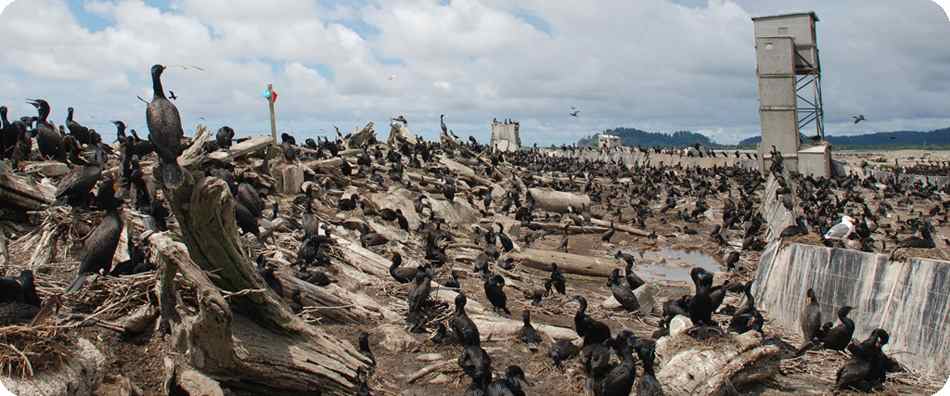forum
library
tutorial
contact

Bird Lovers Start Litigation
Over Corps' Cormorant Plan
by Bill Rudolph
NW Fishletter, April 23, 2015
|
the film forum library tutorial contact |

|
Bird Lovers Start Litigation
by Bill Rudolph
|
"...the Corps has argued that cormorant numbers will likely rebound soon from any temporary losses from its culling action."
 The Audubon Society of Portland has started litigation to block the U.S. Army Corps of Engineers' plan to shoot thousands of salmon-eating cormorants in the lower Columbia River region, the environmental group announced April 14.
The Audubon Society of Portland has started litigation to block the U.S. Army Corps of Engineers' plan to shoot thousands of salmon-eating cormorants in the lower Columbia River region, the environmental group announced April 14.
The Corps got the official go-ahead when the U.S. Fish and Wildlife Service issued depredation permits April 13 granting waivers from the Migratory Bird Treaty Act.
Calling it "wanton slaughter," the Audubon Society said the cormorant management plan will end up killing 15 percent of the double-crested cormorant populations west of the Rockies. The plan was developed as one action in the hydro BiOp to improve juvenile survival of ESA-listed salmonids in the Columbia Basin.
On April 20, five groups filed for injunctive relief in the United States District Court for the District of Oregon to stop the Corps' action.
"This is not about birds versus fish," said Bob Sallinger, Audubon Society of Portland conservation director, in a statement. "The Corps and other federal agencies have proposed rolling back dam operations that benefit salmon while at the same time targeting thousands of cormorants. Blaming salmon and steelhead declines on wild birds that have coexisted with salmon since time immemorial is nothing more than a diversion."
Other parties involved include the Center for Biological Diversity, Wildlife Center of the North Coast, Animal Legal Defense Fund, and Friends of Animals.
The agency is not ready to begin the culling process yet, said Rock Peters, senior fishery program manager for the Corps' Northwestern Division. It calls for shooting up to 3,500 cormorants, and destroying nearly 6,000 nests this year, as the first step in a four-year process. In addition, nearly 4,000 eggs or nestlings would die after their parents are shot, said a statement from the Audubon Society.
Audubon also said that the Corps' plan would put the Western population of the double-crested cormorants below sustainable levels. The plan does estimate bird numbers will dip a few thousand below the 41,000-plus level estimated in 1990 to be sustainable, but the Corps has argued that cormorant numbers will likely rebound soon from any temporary losses from its culling action.
In March, the Audubon Society said the Corps should have examined a variety of alternatives for hydro operations, including increased flow and spill, and reservoir drawdowns to minimum operating pools during juvenile salmon migration, that "could substantially increase the survival of listed juvenile salmon and steelhead during their passage through the FCRPS as well as in the Columbia River estuary."
In 1989, only 100 nesting pairs of double-crested cormorants were counted on East Sand Island, near the mouth of the Columbia River. By 2013, numbers had increased to nearly 15,000 nesting pairs, the largest colony in North America. They were consuming an estimated 18 million salmon and steelhead smolts a year, despite ongoing efforts that have greatly reduced their nesting habitat.
Related Pages:
Audubon Announces Intent to Sue Over Plan to Cull Cormorants from Columbia River Estuary by Staff, Columbia Basin Bulletin, 3/27/15
learn more on topics covered in the film
see the video
read the script
learn the songs
discussion forum
